The Ultimate Guide to Topkapı Palace
Topkapı Palace was the imperial residence, court and state administration of the one of the world’s biggest empires. It also housed the living quarters of the sultans of the Ottoman Empire, otherwise known as the Harem. Without a doubt, it is one of Istanbul’s most popular tourist attractions. Composed around some expansive courtyards and smaller pavilions with some stunning architecture with intricate Islamic geometric patterns, the huge Palace was the official residence for almost 400 years. Construction started in 1459 and was completed in 1478, making it the Ottomans’ second palace in Istanbul. Once constructed, it became the New Imperial Palace replacing the old palace in Beyazit.
It can be considered as one of the world’s biggest palaces in the world. Vast courtyards and many accompanying buildings offer visitors a day full of exploration. In addition, there’s some grand Ottoman architecture, some gorgeous calligraphy, innumerable manuscripts and Ottoman-era relics. You can even the finest Chinese porcelain and Fabergé eggs. They are part of numerous gifts offered to the Ottoman sultans and all in one place – something few attractions anywhere in the world offer!
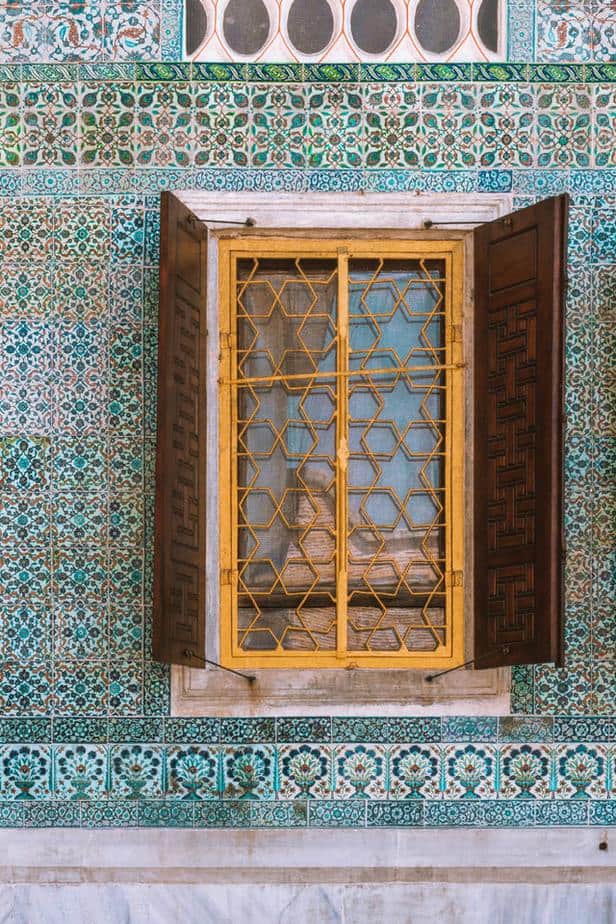
Photo by Jean Carlo Emer on Unsplash
Perched atop a hill overlooking the Marmara and the Golden Horn, the vantage point from some of the palace’s pavilions towards the blue waters of the Golden Horn, the engineering feats of the modern bridges of Istanbul and the Princes’ Islands, is absolutely magnificent! The complex also had libraries, places of worship and houses for princes, mothers of the kings and servants.
Spread over an area of 700,000 sq. meters on the stretch of land now called Sarayburnu or Seraglio (literal translation meaning “palace nose” in Turkish). Topkapı Palace served well over 30 sultans, from Fatih Sultan Mehmet to Sultan Abdülmecid, until the palace was moved to Dolmabahçe Palace in Pera, across the waters of the Golden Horn and the Galata Bridge.

Photo by Mert Kahveci on Unsplash
Subsequent sultans expanded and improved upon the existing structures throughout their years of reign. As a result, it grew expansive and with a variety of different architectural styles and sections. Divided intro three sections, there was an Outer Palace, an Inner Palace and the Harem. The Inner Palace and the Harem served as the private residence of the sultans. On the other hand, the Outer Palace was for guests, the court and administrative officials. The complex housed hundreds and thousands of people, as expected of such a huge palace.
First Courtyard
The first phase of construction was started by Sultan Fatih Mehmet a few years after 1453. That’s the same year he conquered then Constantinople. In fact, the name “Topkapı” means Cannon gate. As the palace got built, cannons were placed on either side of the palace’s walls for defense. Moreover, the most well-known imperial gate, one of three actually, is the Bab-i Humayun. It was first built by Mehmet the Conqueror, as it faces Sultanahmet square and the Hagia Sophia. His Tugra or official seigniorage can be seen on the gate in beautiful calligraphic Kufic Arabic script.
However, before you enter, you won’t want to miss the grand fountain of Fatih Mehmet in the blended style of European and Turkish architecture. The grand fountain is inscribed with calligraphic poetry and has fitted taps on its four corners. It’s placed in a square for passersby to use on a daily basis. It’s in a distinct style of Turkish-Roccoco architecture.
Moving on, as you enter the Imperial gate, the palace is surrounded by four courtyard connecting other buildings, gardens and squares. The whole complex is dotted by rose gardens, beautiful fountains and towers. Inside, you’ll find the palace kitchens, a bakery, hospital, places of worship, the royal mint, and warehouses. For instance, you don’t want to miss the Hagia Irene, a 4th-century Byzantine church and the Enderûn Ağalar mosque.
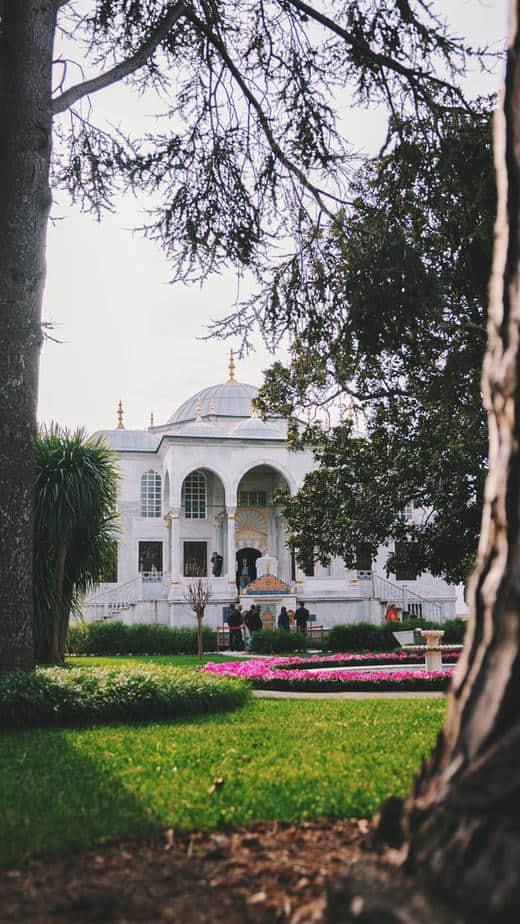
Photo by Linus Mimietz on Unsplash
As you walk towards the next structure you will notice lawns gardens on either side, with plane trees and benches for passersby to rest on. The first courtyard was the only place where peasants and the public could access the palace. As for the style, it showcases the mix of architectural styles employed in the long history of the empire.
At the entrance of the next courtyard is where you’ll see the wonderful Gate of Salutations with its two small conical towers, and the huge iron gate from the time of Sultan Suleiman the Magnificent. Here, you’ll also see the stables, the palace kitchens and its rising chimneys through the red brick walls.
The palace kitchen played an important role in feeding thousands of people everyday and creating many Ottoman dishes and desserts, including, legend has it, the legendary dish Baklava. For more on Turkish desserts, check out the articles on the Top 10 desserts from Turkey.
Some of the many dishes from the Ottoman kitchen have survived today and have carried on with names such as Hunkar Beğendi (“Sultan’s Delight” or literally, “the Sultan Liked it”). This Ottoman cuisine dish is basically a wonderful lamb stew served on a bed of pureed and spiced eggplant. It’s absolutely delicious! Today, you can enjoy it at restaurants such as Hamdi Restaurant Eminönü serving traditional and modern takes on Turkish cuisine.
Second Courtyard
This second courtyard hold institutions where state administration took place, also called the Divan Square or Justice Square. The Divan i.e. the Council Hall was where the official business was carried out. It is marked by the tallest tower in the whole complex also called the Justice Tower or the Divan Tower. This tower is also the one you can see from miles away and is instantly recognizable, even from the Asian side. It was where the sultan would sit and observe his world below. In the following years, it was relocated to the Sublime Porte. The tower is housed in the building of the Imperial treasury. It displays Ottoman era weapons and porcelains artifacts. The Divan proudly displays itself through gilded gold. You can also find porcelain objects as far as China and Japan, attesting to the great wealth of the Ottoman Empire.

Photo by Ümit Karabayır on Unsplash
The Harem
Next you’ll see the most interesting part of the palace and from where you can access the Harem, probably the most beautiful part of the palace. Meaning ‘forbidden’ or ‘private’, Harem is the most intriguing aspect of the palace and sits in the middle of the complex, and had 400 rooms.
Decorated in bright colourful mosaics, gold and stained glass windows with verses from the Quran, the Harem is where you can get a glimpse into the private lives of the sultans and their families and servants. Moreover, the architectural style is a mixture of styles reflecting different sultans and their preferences.

Photo by Jelezniac Bianca on Unsplash
It was heavily guarded and protected and no one but the sultan, the consorts and children and the mothers of the sultans and servants could enter it, as evident in the high walls. You can also find beautifully decorated private quarters and rooms, bathhouses and mosques.
The Harem also housed the Duhteran, an Ottoman school for girls. It trained courtesans and daughters of the sultans on the ways of the palace. Moreover, it also gave the girls an education in languages, religion, reading and writing and etiquette. Topkapı Palace was the palace that the consorts of the sultans lived in the same palace as the sultans. This practise was unlike the previous generations when consorts and women of the court lived elsewhere. The visibility of women was also recognized at this palace, first given to Valide or the Queen Mother, the mother of the sultan. Later, Hürrem Sultan, the consort of Suleiman the Magnificent and one of the most famous Ottoman-era women, also became one of the high ranking officials in the Empire. To visit it today, you’ll need a special pass and extra fees. You should also plan to spend around 1-2 hours here at your leisure.
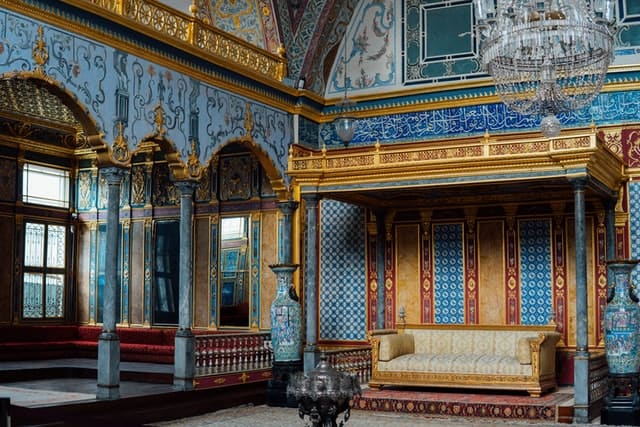
Photo by Mert Kahveci on Unsplash
Fourth Courtyard
In the fourth and last courtyard, you’ll see some highly decorated pavilions and gardens of the palace. This section also houses the Audience hall, the Privy room and the Palace’s school. Pavilions such as the Baghdad, Revan Pavilions, Mecidiye Pavilion and smaller structures occupy this area.
The Gate of Felicity is the entrance to the special private areas of the palace which was heavily guarded. Only the sultan had access to these inner areas. At other times, the area was accessible to few administrators and trusted statesmen. In this area, grand ceremonies such as the sultan’s accession, the beginning of war campaigning and other types of counsel were held in front of the gate. For example, when the Janissaries, a group of elite soldiers, rebelled and demanded better services, the Sultan held counsel here with his administration.
The Audience hall or chamber, as the name suggest, was where state dignitaries and foreign ambassadors were received. The Grand Vizier and other high level statesmen from the Divan would visit the Sultan to present their resolutions and decisions.

Image sourced from Pxfuel
Soon after, you’ll find the library of Sultan Ahmed II built by the famous architect Mimar Sinan. The library’s windows and mother of pearl and ivory inlay is stunning. After that, you’ll find the preserved clothing of the sultans at the Inner Palace as well as holy relics of the Propher Mohammed at the Chamber of Holy Relics. In this area, you’ll also find the Imperial Enderûn institution where young boys were trained as part of the Devsirme law and tax system. In this system, the Ottoman empire would pick children from areas they conquered, such as the Balkans, to train them for state administration.
The remaining buildings opposite the Gate of Felicity today houses exhibits of miniatures, costumes and calligraphy. You can also find an additional treasury with jewelry, thrones, precious gems and decorated weapons such as daggers and similar objects.
Special Pavilions
Additionally, we’ve got Baghdad and the Revan Pavilions built for Sultan Murat IV. The architecture and interiors are outstanding, while the gardens are landscaped with roses and tulips. Another pavilion now serves as a Turkish restaurant with the most amazing view!
To commemorate his Baghdad campaign, Murat IV had it built in 1640 and is perhaps the most well-preserved structure from that time. Architecturally, it is surrounded by marble columns and uniquely shaped with eight sides. Beautiful tile work, mother of pearl and tortoise shell inlay work in the structure’s doors, frames and windows and the Iznik tiles displays the workmanship and style of that era. A heavily decorated dome in the interior is marked by a gold sphere in the middle, and velvet fabrics of the seating invite you to take a wonderful nap or get cozy with a book.
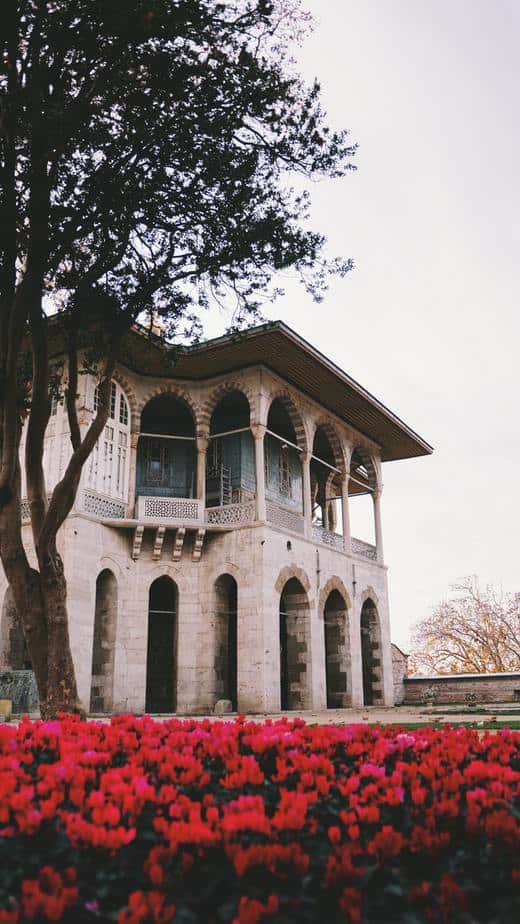
Photo by Linus Mimietz on Unsplash
Nearby, you’re bound to find the Revan Pavilion, built similarly to commemorate the Revan or Transcaucasian campaign (Revan, or rather Yerevan), also built by Murat IV. Beside it, you’ll pass the Sofa Pavilion and the Mecidiye Pavilion. Cutting the two pavilions in the middle is a marbled terrace with a pool. This sea facing terrace, also called the Iftar pergola (Iftar being the breaking of the fast in the holy month of Ramadan), provides an expansive view of the Bosphorus and the Marmara. The Apartment of the Holy Mantle on the opposite section is where you’ll find some holy relics brought back from Mecca by sultan Selim I.
The Sofa Mosque and the Mecidye Pavilion mark an end to the fourth courtyard. As we reach the end of the palace, you’re greeted by the view of the sea. You can take in the view and rest in the gardens below. You’ll then find the Fig garden and the Elephant garden with restricted or blocked access unfortunately. As the name suggests, at one point the Elephant garden housed an exotic elephant, a gift for the sultan. You can only observe this area from the top terraces.
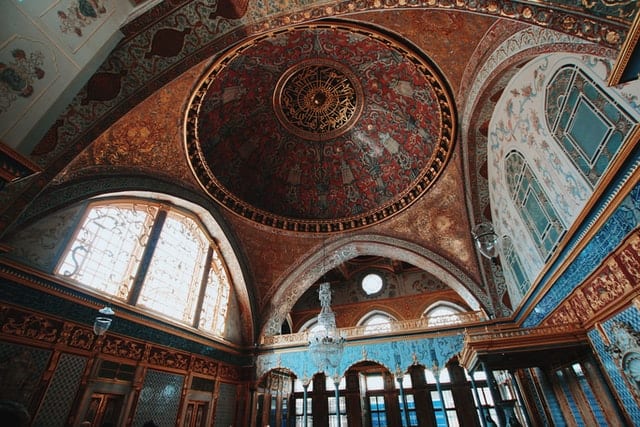
Photo by Artem Bryzgalov on Unsplash
Soon after the creation of the Republic in 1923, Topkapı Palace became the country’s first museum. It can be considered one of the world’s biggest palace-museum complexes given the sheer size. As one can guess, the power and grandeur of the Ottoman Empire is evident in the huge complex. That is, one can imagine how important the Empire was at its peak given the architecture, materials used in the construction and the huge amount of artifacts of the palace. It’s status as a museum highlights this very fact, which is often forgotten in an Eurocentric view of royal palaces and it deserves all the accolades.
Planning a trip to Paris ? Get ready !
These are Amazon’s best-selling travel products that you may need for coming to Paris.
Bookstore
- The best travel book : Rick Steves – Paris 2023 – Learn more here
- Fodor’s Paris 2024 – Learn more here
Travel Gear
- Venture Pal Lightweight Backpack – Learn more here
- Samsonite Winfield 2 28″ Luggage – Learn more here
- Swig Savvy’s Stainless Steel Insulated Water Bottle – Learn more here
Check Amazon’s best-seller list for the most popular travel accessories. We sometimes read this list just to find out what new travel products people are buying.










